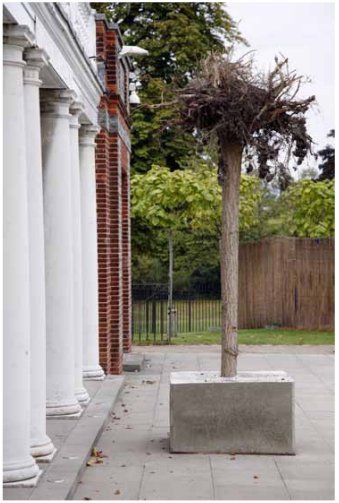Beyond Growth
dal 23/3/2012 al 21/7/2012
Segnalato da
Michel Blazy
Maxime Bondu
Simon Boudvin
Mark Boulos
Blanca Casas Brullet
Charlie Jeffery
Toril Johannessen
Gustav Metzger
Dan Peterman
Thorsten Streichardt
Simon Starling
Superflex
Lois Weinberger
23/3/2012
Beyond Growth
La Ferme du Buisson, Noisiel
An ideal capitalism... The exhibition brings together artists who explore the ambivalence of this notion through experiments in physics, biological cycles, mathematical formulas and critiques of the globalized economy. Their works deal with local as well as international crises while simultaneously reflecting on production and artistic productivity.

Michel Blazy, Maxime Bondu, Simon Boudvin, Mark Boulos, Blanca Casas Brullet, Charlie Jeffery, Toril Johannessen, Gustav Metzger, Dan Peterman, Thorsten Streichardt, Simon Starling, Superflex, Lois Weinberger
"Anyone who believes in indefinite growth in anything physical, on a physically finite planet, is either mad - or an economist."
Kenneth Boulding, The Economy of Love and Fear: A Preface to Grants Economics, 1973
"Though this be madness, yet there is method in’t"
Shakespeare, Hamlet, circa 1599
A model farm, La Ferme du Buisson fed for almost a century a model factory, The Menier chocolate factory,
which was one of the great industrial empires of the nineteenth century. In 1848, sensing that the industrial
revolution would come along with a social revolution, the Menier dynasty attempted to establish a form of
“ideal” capitalism, unique in the history of industry. The production of chocolate grew at a spectacular rate
due to technical, architectural and commercial innovations, the invention of advertising and a multinational
strategy. Concurrently, Menier campaigned for a tax on capital and built a workers housing development for
everyone’s well being, including lodging, a cafeteria, free health care, a school, co-op stores, a savings bank,
etc. “It is thus that all of us, leaning on one another, will move forward with an undivided driving force towards
progress. It is thus that revolutions and revolts will give way to a constant evolution, continuously replacing
the good with the better.”
In the midst of a worldwide economic and ecological crisis, can we still believe in unlimited growth? The
notion of growth, inseparable from the ideas, laws and practices of modernity, is generally perceived as
positive, associated with prosperity and progress seen from the perspective of western humanism. Profit,
productivity, accumulation and expansion became established fundamental values and the myth of growth
and development spread throughout five continents. But it is interesting to remember that at the same time
as the world shifted towards a system founded on productivism and excess, one part of artistic modernity
endorsed an altogether different creed: less is more.
A century later, how do artists address this idea of growth? Many artists investigate the idea of growth,
whether in relation to economics, urbanism, physics, biology or botany, but they also use it as a way to
question their own working methods. Echoing a series of exhibitions in Switzerland and Germany in 2011*,
Beyond Growth brings together artists who explore the ambivalence of this notion through experiments in
physics, biological cycles, mathematical formulas and critiques of the globalized economy.
Watching a famous American fast food chain being gradually swallowed up by water, we catch sight of a
boat slowly crossing a lake as it self-destructs; while exogenous plants overrun the ruins of western cities,
fishermen in the Niger Delta attempt to protect their resources from the havoc wreaked by oil companies and
Danish households invest in real estate thanks to hurricane Katrina...
Recalling what Naomi Klein termed “disaster capitalism”, these works deal with local as well as international
crises while simultaneously reflecting on production and artistic productivity. The artists appropriate the
rationale of growth, exploiting its possibilities, such as organic processes of mutation, movement, excess,
desire for proliferation and self-creation as well as its limits, such as saturation, overflow, pollution, loss of
control and alienated work. While neoliberal economics ignore the phenomena of unproductive expenditure
and entropy, i.e. the irreversibility of transformations in energy and matter, these artists place them at the
center of their preoccupations to raise questions which are as aesthetic as they are economic, ecological
and political.
*On the Metaphor of Growth, Kunsthalle Baseland (Basel), Frankfurter Kunstverein (Frankfurt), Kunstverein Hannover
(Hanover)
Image: Gustav Metzger, Mirror Trees, 2009. Trees, concrete blocks, variable dimensions. Courtesy the artist © Jerry Hardman-Jones
Press relations
Julie Pellegrin - Director +33 (1) 64 627711 julie.pellegrin@lafermedubuisson.com
Mélanie Jouen- Communication Manager +33 (1) 64 627728 melanie.jouen@lafermedubuisson.com
Opening Saturday March, 24 from 3 p.m.
Free shuttle by reservation at 2.30 p.m. / Opera house-Bastille
Sunday June, 17 at 3 p.m. : lecture and screening by Simon Boudvin
Contemporary Art Center La Ferme du Buisson
Allée de la Ferme - Noisiel
77 448 Marne-la-Vallée cedex 2 France



